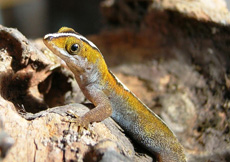Gonatodes vittatus
(WIEGMANN, 1856)
Distribution:
Aruba, Coche, Cubagoa, Curacao, Colombia, Los Frailes, Los Testigos, Margarita, Venezuela, Trinidad and Tobago
Description:
The name vittatus in Latin means "striped lengthwise". The longitudinal stripes on the back can be seen in both sexes, however in males, they clearly display with more contrast. In males, the white stripe runs from the tip of the snout to the end of the tail. From the head to the start of the tail, the male has black lines, which show strong contrast and on the tail itself it looks blurry and indistinct. Dorsally they are yellowish brown. The flanks and belly are usually gray to gray-blue. The males also have a typical pattern on the throat, it consists of a black stripes on a white background and tends to also be visible after two to three months in young animals. There is also another pattern variant (probably a subspecies), where the throat of the males appears pure yellow!
Gonatodes vittatus also demonstrates the typical sexual dimorphism between sexes. Females of the species are gray-brown with light gray and brown spots, some black spots are also visible. The throat of the plainly colored females is patternless.
Both sexes on average reach an overall length no larger than 8 centimeters, but there is also some animals which reach on overall length up to 10 centimeters.
Habitat:
Gonatodes vittatus is found in warm humid to semi-arid habitats. This species is often, like many other Gonatodes species, described as inhabiting soil. They are very good climbers and are more preferably present in trees, rock crevices, roots and walls. In the terrarium, they will hardly be observed on the ground. Here the animals are mainly seen on rough vertical structures. Gonatodes vittatus has shown itself to be synanthropic, inhabiting colonized gardens, parks and building walls.
Husbandry and Breeding:
Unlike the other usually very shy species of the genus, Gonatodes vittatus is easily observed in the terrarium. Due to their nature, there should only be one pair per terrarium. The enclosure should be higher rather than wide, for a pair a terrarium measuring 40x30x50 centimeters will be sufficient. For the design it is advisable to affix cork panels to the rear and side walls, so that more space is created for them to climb. By attaching additional pieces of cork to the back wall, narrow cavities are created, allowing the animals to hide, should they feel the need to do so. The planting is up to you, but I do recommend some trailing plants, to offer the animals additional security. A few climbing branches or fake tree roots should also be added. A small bowl of crushed up cuttlefish bone, for the breeding females, completes the setup.
Daytime temperatures should range between 24-28°C (75-82°F), at night they may fall by three to seven degrees safely. In larger terrariums a place for the animals to warm up should be provided, the basking site may reach 35°C (95°F) safely. Halogen puck lights fill the need for this purpose very well.
During the breeding season, the females will lay a single egg at three weeks intervals. To offer the female a place to lay her eggs, small tubes of Japanese knotweed (Reynoutria japonica) or similar should be placed at different heights against the rear and side walls. It is important to note that whatever type of tubes you select, that the insides should be checked to make sure they are not too smooth, as Gonatodes lack the ability to climb smooth surfaces! Once the female has selected a nesting site, it is mostly used again and again. Because the females do not glue their eggs, they can be easily removed for incubation. Incubation temperatures between 25-30°C ( 77-86°F) will result in the young hatching out between 65-110 days. Incubation temperatures of 27°C (80.6°F) seems to result in nearly equal sex ratios. Upon hatching, the young animals roughly measure 3 centimeters.
When selecting an enclosure to raise the young, it is important that you choose one which is well ventilated. To offer a constant level of food the enclosure should be seeded with springtails and small woodlice. Young animals of the same size can be raised together in small groups. When providing illumination for the offspring, it is important to note that UVB lamps should be avoided, as our own observations and that of other breeders suggest that too much direct exposure could result in shedding problems.
Their diet should be well varied. The adults diet can consist for example of; small crickets, large Drosophila, houseflies, Buffalo larvae, several small isopods, firebrats and field sweepings. Bean beetles will also be taken, however it will be very reluctantly. Their young should be offered small prey; Drosophila, micro crickets, tropical springtails, firebrats and field sweepings.
Overall Gonatodes vittatus is an attractive and easy species which is well suited for beginners.








